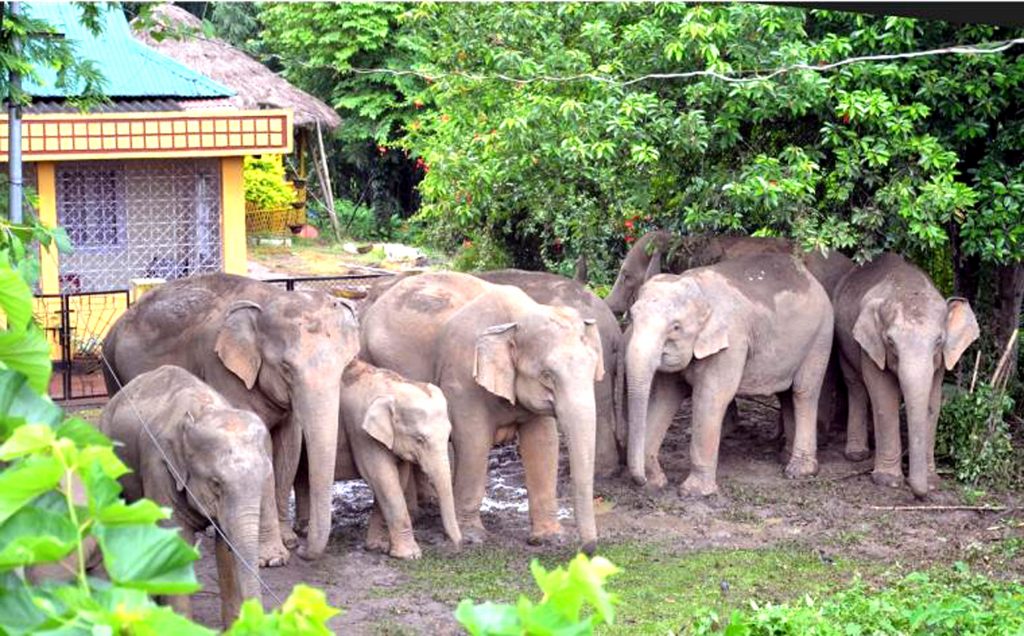From Bhupen Goswami

Guwahathi: In Assam, Elephants orchestrated, the Indian Army lost crores of rupees in Assam. A herd of elephants from guwahati wildlife sanctuary in Assam destroyed the houses of indian army security camp in The Indian Army areas and in Kamrup metropolis. An army official informed this and said that every day the Indian Army is tired of avoiding 20-30 elephants and it has become difficult for the army to continue. The army has asked the government to either remove elephants from the wildlife sanctuary adjoining its eastern base in Guwahati or compensate the damage caused by elephants. The Amchang Wildlife Sanctuary, spread over 78.64 sq km, has about 50 elephants, often entering the army area and vandalising them.
The army claims that crores of rupees have been lost due to elephant disturbance in the last six months. But wildlife experts have rejected the army’s proposal. It is important to mention here that about 800 elephants have been killed in the state for various reasons since 2010. The problem of elephant entering and sabotage in military camps is very old, especially due to dense forests in the north-eastern region. Although the army has been taking measures such as setting up barbed wire fences and the Watchtower at its level, it is inadequate.
Wild elephants are often breaking fences and entering army camps and cantonment areas. There is no provision for appointment of any environment officer on the part of the army so far nor any other measure. In the event of elephant entering, the Army Jawans fill them in ways like fire and noise. In serious cases, the forest department is also informed. Guwahati, the capital of Assam, has the largest army orange military station. About six kilometres long border is from the Amchang Wildlife Sanctuary. Elephants from the sanctuary often reach the military area and sabotage them. On the same issue, Maj Gen Jarken Gamlin, General Officer Commanding (GOC) of 52 sub-area of Orange Cantt, has sent a letter to the Chief Secretary of the state stating that either the elephants living in the said sanctuary should be sent elsewhere or the government should pay crores of rupees as compensation for the damage caused by sabotage.
Army seeks compensation of crores from forest department of Assam government. The letter was written on July 3, but it has now come to the fore with an information sought under rti on behalf of environment activist Rohit Chaudhary. There are about 50 elephants in the said in-the-same. The army claims that three of them have suffered heavy losses during the last six months. The letter says that the Orange Centre is the logistic hub of the army in the north-east. In 2002, the army had launched a scheme for iron fencing to curb elephant attacks. But the forest department had objected to it last year saying that elephants are being harmed by pointed iron rods. Thereafter, the fence was withdrawn.
The forest department says that at least two elephants have died and several others have been injured during the year 2018-19 due to pointed rods. On the other hand, the army argues that elephant attacks are continuously increasing after the fencing is removed. This has increased the risk of damage to the people and infrastructure living in the cantonment. “A herd of three elephants is suffering the most,” says a senior army official on the condition of anonymity. The first elephants came in a large herd. But they returned without any harm. But now their attacks have increased for the past few weeks. However, a forest official from Guwahati met tea plantation workers in elephant affected area Jorhat district.
He has suggested to the army to place one kilo of red chillies in the army camp and grind it into cow dung and keep the kons. It may be noted that the elephants flee by burning it. On Monday night, panic broke out in the military camp as 15-16 elephant teams rushed to the military camp and made arearchestrated . Meanwhile, A senior forest officer said that the Elephants have a bleak future. Already on the endangered animals list, elephants are rapidly losing their habitat, and new research suggests they will lose about half of their habitat today in Assam by the end of the 21st century. Assam and North east in India are home to about 60% of all wild Asian elephants (Elephas maximus). Other subspecies are found in Sri Lanka and Sumatra.
In India, these elephants are found in the forests and hills of several southern, eastern and northeastern states. In the north India , they have made their homes in the foothills of the Himalayas.The pachyderms need large areas to live and feed, tracts of land about the size of Nagpur or bigger. However, such real estate is hard to come by while whatever is already available becomes more fragmented. Together with poaching for tusks, hide and meat, the number of Asian elephants has been falling, and they have been on the endangered list for several decades now. Climate change means it’s only going to get worse. So to predict how different factors could affect elephant populations in the future, Rajapandian Kanagaraj of the National Museum of Natural Sciences, Madrid, and an assortment of international researchers modelled their future habitats and ranges.


